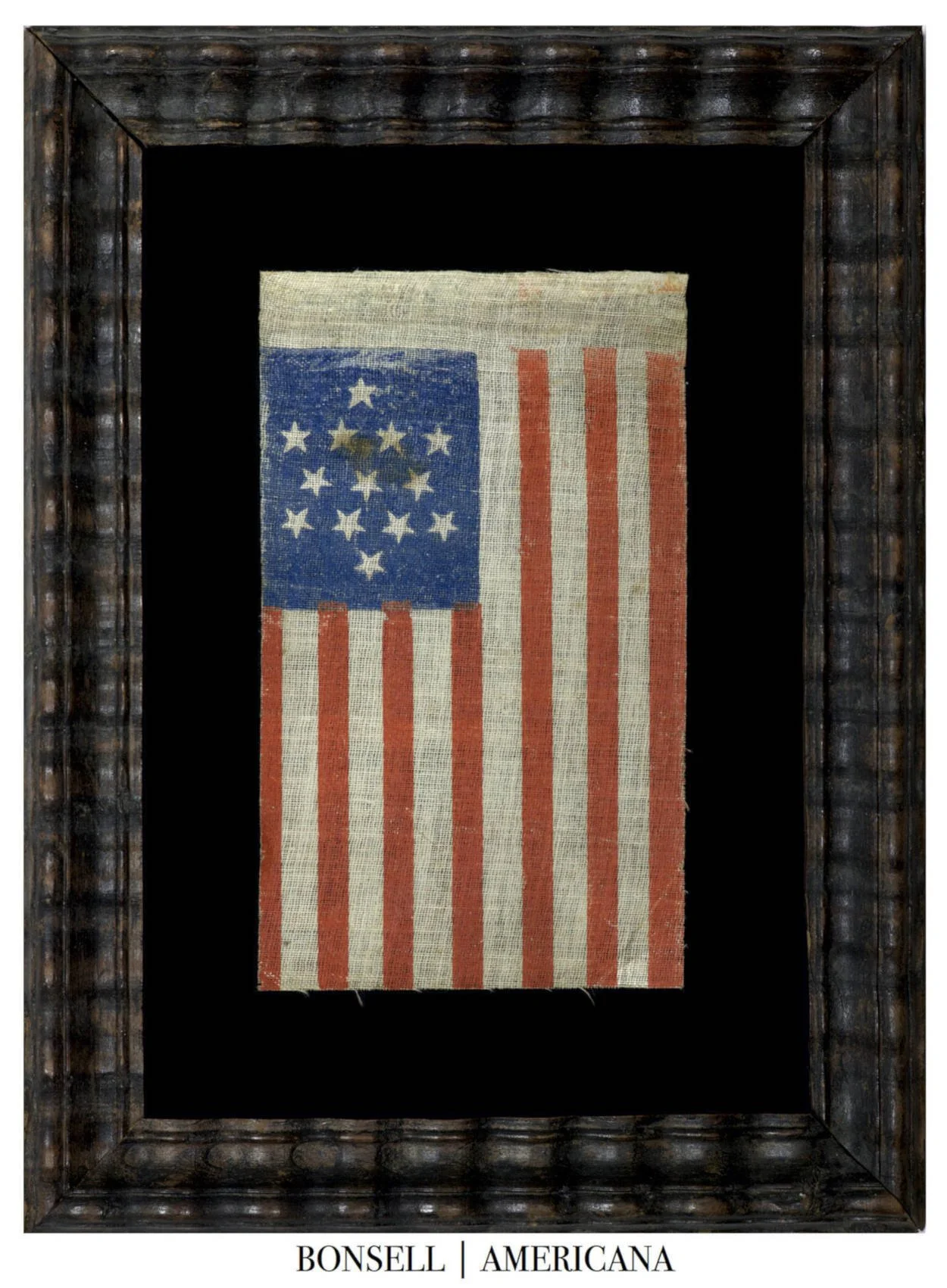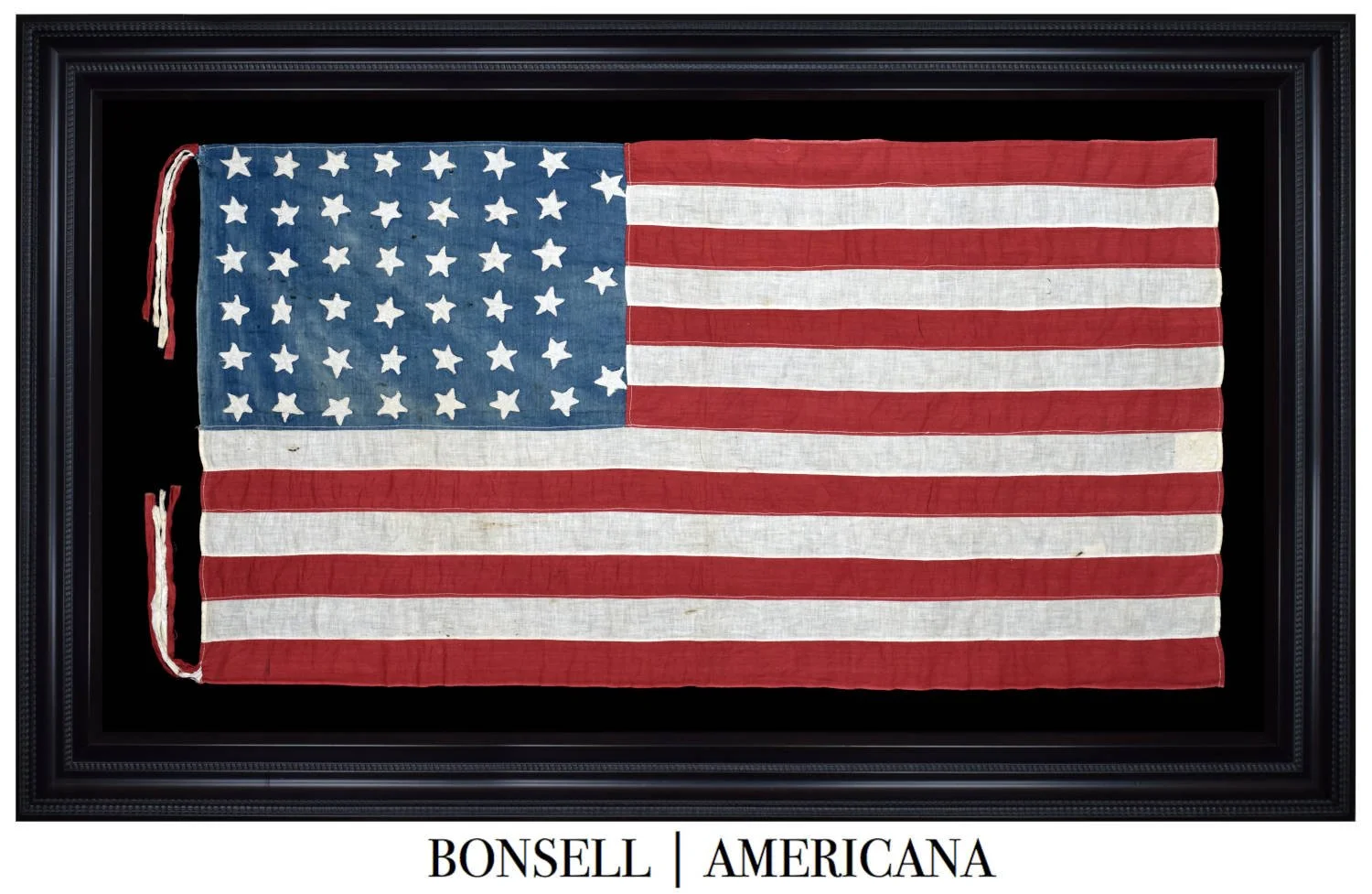39 Star Antique American Flag | The First Example We Have Encountered in this Form | North Dakota Statehood | Circa 1876-1889
39 Star Antique American Flag | The First Example We Have Encountered in this Form | North Dakota Statehood | Circa 1876-1889
Frame Size (H x L): 9” x 10.5”
Flag Size (H x L): 5” x 6.5”
Offered is a rare thirty-nine star flag made of silk, featuring a star arrangement in a unique 8-8-8-7-8 pattern. The stars, tightly packed and tumbling relative to one another, give the flag a dynamic appearance, while the canton displays a cornflower blue hue. A decorative gold fringe lines the top, right, and bottom edges, adding a touch of formality.
Thirty-nine star flags are a peculiar rarity in American flag history, as the star count was never official. These flags were produced at two distinct times, first in 1876 and later in 1889, each time based on speculation about state admissions. In 1876, as the United States approached its Centennial, flag makers anticipated the admission of an additional state alongside Colorado. This led to the creation of thirty-nine star flags, skipping over the thirty-eight star version that should have reflected Colorado's solo admission. This speculative jump in star count was reflected in various patriotic items, including centennial quilts, though it was ultimately incorrect as Colorado was the only state added in 1876.
The second wave of thirty-nine star flags appeared in 1889, when it was widely expected that the Dakota Territory would be admitted as a single state. The Dakota Territory, originally organized in 1861, had grown significantly in population by the late 1880s, leading to pressure for statehood. It was largely assumed that Dakota would be admitted as a singular entity, resulting in the production of anticipatory thirty-nine star flags. However, political disagreements at both the federal and local levels complicated the process.
One of the key issues surrounding Dakota's statehood involved regional disputes between the northern and southern parts of the territory. The northern part, largely settled by immigrants and farmers, and the southern part, with its commercial and railroad interests, had differing priorities. Additionally, the Republican Party saw an advantage in splitting the territory into two states, which would likely send four Republican senators to Congress instead of two. This strategic decision led Congress to pass legislation dividing Dakota into North Dakota and South Dakota. On November 2, 1889, President Benjamin Harrison signed proclamations admitting both North Dakota and South Dakota as separate states on the same day.
This unexpected move not only invalidated the thirty-nine star design but also resulted in a rapid increase in the official star count from thirty-eight to forty stars, with further additions of Montana, Washington, and Idaho in the same year, bringing the total to forty-three stars by 1890. The sudden shift caught many flag makers off guard, as they had anticipated Dakota's admission as a single state, leading to the creation of numerous thirty-nine star flags that were ultimately never official.
According to the Flag Act of 1818, new stars were to be added to the U.S. flag on the Fourth of July following a state's admission to the Union. In 1889, five states were admitted in quick succession, leading to one of the most dramatic changes in the official flag's history. Despite this, flag makers during the year produced numerous speculative thirty-nine star flags, which remain as fascinating historical artifacts that reflect the uncertainty and anticipation surrounding statehood during this period in U.S. history. The division of the Dakota Territory into two states marked a pivotal moment in American politics and geography, as it symbolized the increasing complexity of managing westward expansion and state admissions during the late 19th century.
Conservation Process: This flag was professionally conserved. It is sewn to silk and positioned behind Optium Museum Acrylic.
Frame: The antique ripple frame features evenly spaced, wavy ridges with a black finish and subtle highlights that create depth and texture. It dates to between 1850 and 1870.
Condition Report: The flag is in overall good condition, with a decorative fringe that remains intact. There are some minor splits in the silk, and light discoloration is present.
Collectability Level: The Great – Perfect for Rising Collectors
Date of Origin: 1876-1889
Number of Stars: 39
Associated War: Indian Wars (1860-1890)
Associated State: North Dakota









